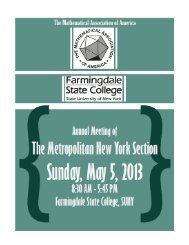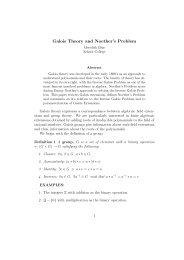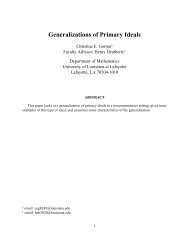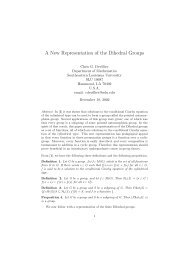Presentation Abstracts - MAA Sections
Presentation Abstracts - MAA Sections
Presentation Abstracts - MAA Sections
You also want an ePaper? Increase the reach of your titles
YUMPU automatically turns print PDFs into web optimized ePapers that Google loves.
UGH.1 Joseph Scott Georgia College<br />
Dr. Darin Mohr<br />
Implicitly Defined Baseball Statistics<br />
In Major League Baseball, the batting champion is given to the player with the highest batting average. The Cy Young<br />
Award winner is given to the top pitcher and is determined by a combination of statistics including earned run average<br />
(ERA). These statistics do not consider the strength of the opposition. We develop two implicitly defined statistics that<br />
determine the value of a batter and the value of a pitcher based on the relative skill of the opposing pitcher and batter<br />
respectively. This statistic relates a player's performance with the skill of the opposition and allows us to identify the best<br />
hitter and pitcher of a specific season.<br />
GT2.5 Valeriia Sherina Georgia Southern University<br />
Disclosure Risk of the Hybrid Method of the microdata protection<br />
The purpose of Statistical Disclosure Limitation (SDL) is to protect statistical data in such a way that dissemination and<br />
analysis of this data can be made without giving away confidential information that can be linked to specific individuals,<br />
businesses, or entities. The application of SDL techniques involves balancing two competing objectives: the minimization<br />
of disclosure risk and the maximization of data utility for the legitimate data user. In this research we study the disclosure<br />
risk of the hybrid method of microdata protection that consists of clustering the records first and then synthesizing them<br />
independently for each cluster.<br />
UGA.1 Christopher Shill Elon University<br />
Chad Awtrey<br />
Galois 2-adic Fields of Degree 12.<br />
An important problem in computational number theory is to clasify all nite extensions of the p-adic numbers by<br />
computing important invariants which dene each extension. Current research has focused on computing Galois groups of<br />
these extensions up to degree 11. Consequently for this talk, we will focus on degree 12 extensions. We will begin with a<br />
brief overview of p-adic numbers and will conclude by discussing a method for calculating Galois groups of Galois<br />
extensions of the 2-adic numbers.<br />
PRO1.4 Andrew Simoson King College<br />
From Newton to Nim: inviting journal problems to class<br />
We give two examples of classroom incorporation of lists of problems from various journals.<br />
We chronicle how introducing a Math Horizon's nim-like problem into a number theory course led to a student <strong>MAA</strong><br />
poster and a student publication; and how an examination of Newton's Prinicipia in both a History of Math Class and a<br />
Vector Calculus course resulted in new entries for the problem sections of the CMJ and the Math Magazine.<br />
GT1.4 Nicholas Sizemore Western Carolina University<br />
Group Covers: Covering and Partition Numbers<br />
A group cover is a collection of proper subgroups whose union is the group. One can also consider a partition, which is a<br />
group cover consisting of subgroups with trivial intersection. Of interest in this talk will be the covering number, which is<br />
the minimal number of subgroups necessary to form a cover, and the partition number, which is the minimal number of<br />
subgroups necessary to form a partition.<br />
The key question will be, "When is the covering number strictly less than the partition number?", which will motivate<br />
some interesting results. In particular, the dihedral groups are turn out to be quite interesting, and we can completely<br />
classify the relationship between the covering and partition number of these groups.<br />
INQ.3 Cornelius Stallman Georgia Regents University Augusta<br />
Can you teach calculus using the Moore Method and still cover the material?<br />
During the past ten years I have used a modified Moore Method approach in teaching calculus.<br />
The benefits of a Moore Method course are known to many who experienced such a course in graduate school or in an<br />
upper level undergraduate course. Calculus presents a special challenge to the would-be Moore Method practitioner. How<br />
will you cover the material? Is it possible? Does it matter? What does “covering the material” mean?<br />
I hope to address these questions as well as shed some light on how Moore Method/IBL practices can address some of the<br />
recent concerns about the state of undergraduate education expressed in for example Academically Adrift and Our<br />
Underachieving Colleges.

















